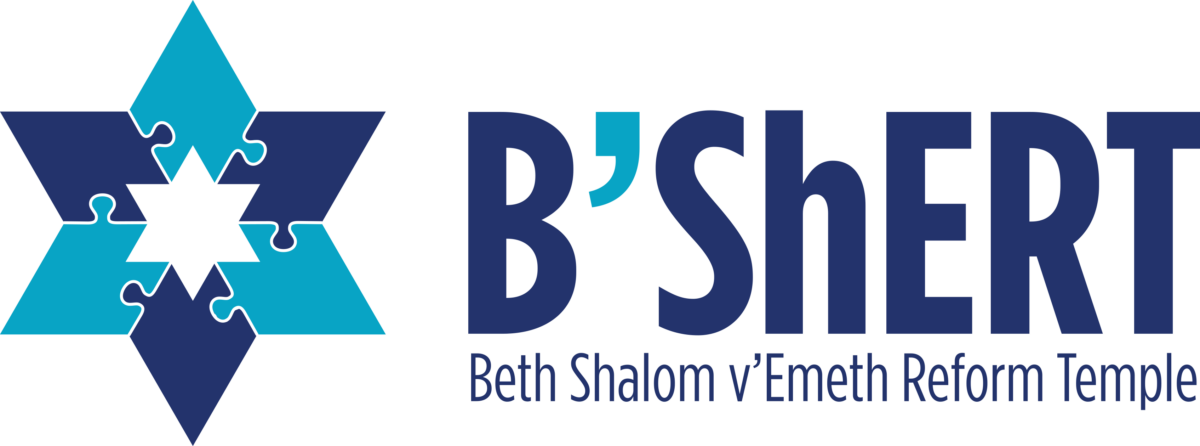About Our Temple(s)
Progressive Temple Beth Ahavath Sholom
Progressive Temple Beth Ahavath Sholom (PTBAS), a member of the Union for Reform Judaism, was a consolidation of three synagogues, Beth Sholom People’s Temple established in 1905, Temple Ahavath Sholom established in 1912 and Progressive Synagogue’s constitution and by laws adopted in 1919. Together we embrace the shared and proud union of these long standing congregations.
We are a congregation with a warm and caring approach to tradition. Our Temple actively promotes the programs and values of Reform Judaism: each of us is created in the divine image. We value informed personal choice. We are dedicated to tikkun olam, the repair of the world through social action. We encourage men and women to participate equally in all religious duties.
Temple Beth Emeth v’Ohr Progressive Shaari Zedek
In 1908 there were few Jewish families in Flatbush Brooklyn. In that year, Hannah Hirsch was concerned with providing her children with a Jewish education. She invited some of her Jewish neighbors to her home for a group discussion. That meeting resulted in the establishment and organization of the first reform religious school in Flatbush. For the next three years, the school held classes in Dilliard’s French Bakery and Dining Room on Cortelyou Road at East 16th Street.
On May 17th 1911, Mrs. Hirsch’s group of thirty-five Jewish families met for the purpose of organizing a liberal reform congregation. They met at the Savoy hall at 854 Flatbush Avenue. It was voted on that annual dues would be set at $12.00 and that any money received as donations go toward a building fund. On October 17, 1911 the name of the congregation was established as Temple Beth Emeth of Flatbush (the House of Truth).
In November 1911, a call was made to Rabbi Samuel J. Levinson of Yonkers, NY. Rabbi Levinson accepted the invitation to return to his native Brooklyn and lead the congregation. He was formally installed as Rabbi of Temple Beth Emeth in February 1912 at an annual salary of $500.
Rabbi Levinson soon embarked on a campaign to develop a permanent structure for the Temple because services were still being held at the Savoy Hall. The first location considered for a building site was the southeast corner of Westminster Road and Ditmas Avenue. The land was to be purchased for the sum of $9,000, however, the deal was not finalized because there was a restriction against a “church” being erected on that site. The next location selected was the southeast corner of Marlborough Road and Church Avenue. The congregation paid $6,300 for the property on September 9, 1912. The cornerstone was laid on July 30, 1913 and on Rosh Hashanah Eve, 1914, the new Temple was dedicated.
The membership grew rapidly in just a few years. More space was needed for the classrooms and meeting rooms and in 1922 an addition to the sanctuary was added. By the mid-1930s, Temple Beth Emeth boasted one of the largest men’s clubs in the country with over 800 members. The sisterhood numbered over 400 members and the religious school was one of the best around. In 1936, Rabbi Levinson celebrated his 25th year at Temple Beth Emeth.
Also, in 1936, the sanctuary was renovated and changed to an art-deco design and air conditioning was installed. A bronze Ark was designed and presented as a gift to the Temple. The renovations added greater beauty and warmth to the sanctuary and it came to be known as the little “Jewel Box.”
In the late 1960s a massive exodus of Reform Jews from Brooklyn began which decimated the membership of four congregations. By the 1990s, the merging of these congregations resulted in today’s Temple Beth Emeth v’Ohr Progressive Shaari Zedek keeping the flame of Reform Judaism alive in Flatbush.
In 2011, the congregation celebrated its centennial year and made some new history with the hiring of its first female rabbi. Rabbi Heidi Hoover began her full-time tenure at Temple in June of 2011 and was officially installed in January of 2012. She is the successor to Rabbi William Kloner z”l, who served this congregation faithfully for more than 30 years while continuing his responsibilities as a naval chaplain and Rear Admiral in the National Guard; she also succeeded Cantor Suzanne Bernstein, who retired after serving as the spiritual leader of PTBAS for several years.
In 2019 the congregation added an Associate Rabbi & Educator, Rabbi Alexis Pinsky, who joined Rabbi Hoover and Cantorial Soloist Nonie Schuster Donato on the bima.
How did Progressive Temple Beth Ahavath Shalom (PTBAS) and Temple Beth Emeth v’Ohr Progressive Shaari Zedek (TBEPSZ), become Beth Shalom Emeth Reform Temple (B’ShERT)? History compiled by Ron Schweiger.
Progressive Temple Beth Ahavath Sholom:
1905 Beth Shalom Peoples Temple (BSPT) is founded.
1912 Temple Ahavath Shalom (TAS) is founded. The cornerstone is laid on August 3,1912 on the corner of Avenue R and East 17th Street. It is known as the Avenue R Temple.
1919 Temple Ahavath Shalom expands and erects a larger building on the next corner on Avenue R and East 16th Street. The original building is demolished.
1920 The dedication of the new building of Temple Ahavath Shalom is on June 20, 1920. Rabbi Peiper of TAS is honored. One of the other speakers at the dedication is Rabbi Samuel Levinson from Temple Beth Emeth.
1919 Progressive Synagogue of Borough Park is founded. Its charter is filed in the Kings County Clerk’s office on April 29, 1919.
On November 13, 1919, the property of the Borough Park Presbyterian Church on 15th Avenue and 46th Street, is purchased for $24,000. Fifteen members of the Progressive Synagogue of Borough Park, loan the congregation $19,500. The church building is then moved onto 46th Street and the now empty 15th Avenue site is sold for $15,000.
1944 Around 1944, the congregation purchased the Northeast corner of Ocean Avenue and Avenue I, in the Flatbush/Midwood community.
1952 Ground was broken to erect the new synagogue. The cornerstone was laid on November 16, 1952.
1955 The new Progressive Synagogue on May 21, 1955. The old home of the Progressive Synagogue in Borough Park was sold to them for $15,000. Now there were two progressive Synagogues, Borough Park and in Flatbush.
1994 Temple Ahavath Shalom (TAS) and Beth Shalom Peoples Temple (BSPT), consolidate. Their new name becomes Temple Beth Ahavath Shalom (TBAS).
2004 Temple Beth Ahavath Shalom (TBAS) consolidates with Progressive Synagogue of Borough Park to form Progressive Temple Beth Ahavath Shalom (PTBAS).
Temple Beth Emeth v’Ohr Progressive Shaari Zedek:
1902 Congregation Shaari Zedek is organized in Stuyvesant Heights.
By the 1970’s, Shaari Zedek merged with the Progressive Synagogue on Ocean Avenue and Avenue I. The new name became Progressive Shaari Zedek.
1911 Temple Beth Emeth was founded on May 17,1911 with about 30 families. In early 2012, the Southeast corner of Marlborough Road and Church Avenue was purchased for $6,300.
1913 The cornerstone for Temple Beth Emeth is laid on July 21, 1913. The first Rabbi, Samuel Levinson, started a building campaign to erect a sanctuary. Since there was no sanctuary yet, services were held at the Savoy Hall at 854 Flatbush Avenue. The first High Holiday services were held at the Unitarian Church on Beverley Road and East 19th Street.
1914 The new sanctuary was completed at a cost of $40,000. It was dedicated on April 14, 1914.
1920 As membership rapidly increased at TBE, more classroom and office space was needed. The house adjacent to the sanctuary on Marlborough Road was purchased for $21,000.
1920-1922 During the construction of the new Community Building, the sanctuary was not able to be used. Rabbi Peiper of Temple Ahavath Shalom invited Rabbi Levinson and the Temple Beth Emeth congregation to worship at his Temple on Avenue R.
1928 Cantor Walter Davidson becomes the Cantor at Beth Emeth and remains for 60 years until 1988 when he retires.
1990 Progressive Shaari Zedek on Ocean Avenue and Avenue I sells its building to an Orthodox girls school and mergers with Temple Beth Emeth. The new name becomes Temple Beth Emeth Progressive Shaari Zedek.
1994 Community Temple Beth Ohr on Ocean Avenue and Newkirk Avenue sells its building and consolidates with Temple Beth Emeth Progressive Shaari Zedek. The new name of the congregation becomes Temple Beth Emeth v’Ohr Progressive Shaari Zedek.
From 2008 -2017, there was communication between PTBAS and TBEPSZ. There was discussion, meetings, more discussion, more meetings, negotiations, head scratchings, and of course, more meetings. FINALLY, a new consolidation was formed. There was now a PROBLEM! How do we come up with a name to combine PTBAS with TBEPSZ? The answer is simple:
Beth Shalom Emeth Reform Temple. B’ShERT!!!!! It was truly, meant to be.
I want to thank Stanley Hollander and Eric Platt for gathering the history of PTBAS. Thank goodness the past generations of both congregations had the sense to keep their records. Thanks to Jeff Levinson and Eric Platt for enabling the two congregations to come together.

